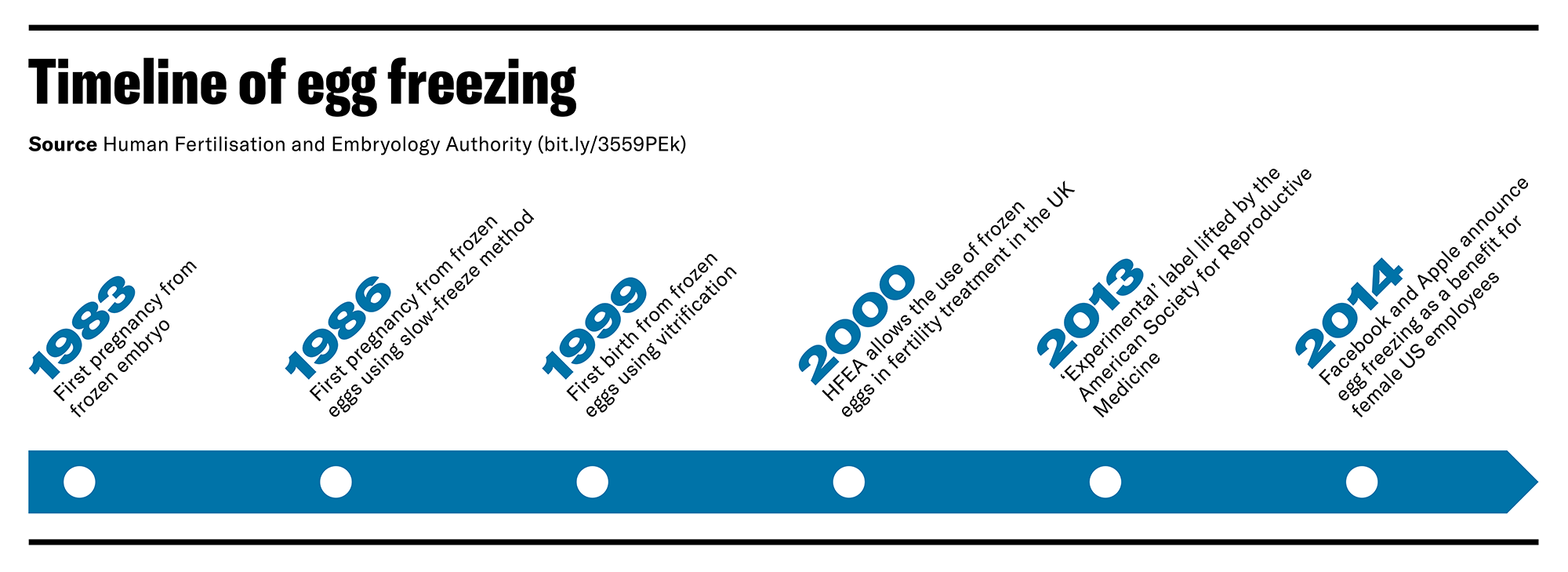Louise Brown, the world’s first IVF baby, was born in 1978, the culmination of decades of research by Cambridge Nobel scientist Sir Robert Edwards. Since then, an estimated eight million babies have been born globally following IVF and other assisted reproductive technologies (ARTs).
While many different personal journeys have led to these births, there has typically been one unifying rationale: I want a baby, preferably as soon as possible. That’s all changing.
The fastest-growing tech in the reproductive marketplace is ‘oocyte cryopreservation’, or egg freezing. In its early days, it was a resort for women with cancer diagnoses, but very low success rates often led to little more than false promise.
The technology has improved dramatically. An egg is the largest cell in the human body and freezing can cause crystal formation in the cell. Slow-freezing techniques were initially used to circumvent this problem, followed by the more successful flash-freezing ‘vitrification’ that transformed the egg into a glass-like stasis, after which success rates for post-thaw conception jumped.
What became apparent was the potential egg-freezing client base outstripped that of IVF alone, as it included not just women who want a baby, but also all those who might want a baby in the future.
“Egg freezing is both an infertility treatment for the fertile and a fertility treatment for the infertile,” says Franklin’s colleague Dr Lucy van de Wiel, whose research focuses on the explosion in the popularity of this ART. “Increasingly younger women are encouraged to freeze their eggs in preparation for future infertility, and those frozen eggs promise an extension to fertile life.”
By 2013, many of the world’s professional fertility bodies had stopped labelling the treatment as ‘experimental’, triggering a gold rush in egg-freezing investment and marketing. Van de Wiel’s book Freezing Fertility, published by New York University Press, tracks this rapidly expanding offshoot of the fertility industry, and the people it aims to attract.
“We’ve always had commercialisation of IVF, but there’s a large amount of private equity and venture capital investment pouring into egg freezing – often coming from places with no links to the fertility industry,” says Van de Wiel.

Start-ups focusing on clinical freezing services are seeing such an influx of capital that they are acquiring many established independent IVF clinics, creating corporate fertility franchises unlike anything previously seen.
The target customers for these new conglomerates are not just women in their mid-thirties but those a decade younger. And the marketing pitch isn’t a newborn babe, but rather freedom and reproductive control.
“Look at Prelude, founded by an IT entrepreneur,” says Van de Wiel. “Within two years they had bought dozens of clinics across the USA, and now claim to be the country’s largest fertility company. Much of their marketing depicts single young women, not families with babies.
“Their pitch to women is: freeze your young eggs, use our extra testing, so you have the best genetic material for making a baby when the time is right for you. Feel reassured that you can live free from your body clock, because meeting the right partner at the right age and conceiving through sex is too unpredictable.
“Their pitch to investors is: with our treatments, people can have children when they are ready, even if that is at a time when they are no longer fertile. Combined with fertility demands for same-sex couples, it’s a market set to increase – and one likely to stay strong in economic downturns. Children are priceless; people are willing to spend a lot to have them.”
She adds: “While the average age of a woman freezing eggs in the UK is still 37, there is an idea increasingly sold that the younger you do it the better. I’ve heard about fertility preservation stalls at graduate fairs.”
Freezing can lock women into a financial cycle. Eggs need to be stored, which means regular payment, ranging from upwards of £200 annually in the UK to over $1,000 in the USA. The more eggs, and the more cycles, the higher the chances of conception down the line. Some countries impose a shelf life – eggs are destroyed after 10 years in the UK.
The new industry has got this covered. Some start-ups specialise in fertility loans or subscription plans. In the USA, fertility insurance packages that include egg freezing are used by employers to attract the best female graduates or executives.
The expansion of ARTs can create “new forms of dependency,” says Van de Wiel, as well as reproductive anxieties in women from younger ages. “Certain demanding careers may come to be seen as contingent on ARTs such as egg freezing if women entering them want the option of children. To have a healthy child at the best time, women can become reliant on companies to test their fertility, or preserve and store their eggs, or implant a healthy, tested embryo.”
Van de Wiel says she’s all for technologies such as egg freezing, “but it’s important to stay well informed, and not just about the biological facts, but also the business structures you’re participating in.”





























